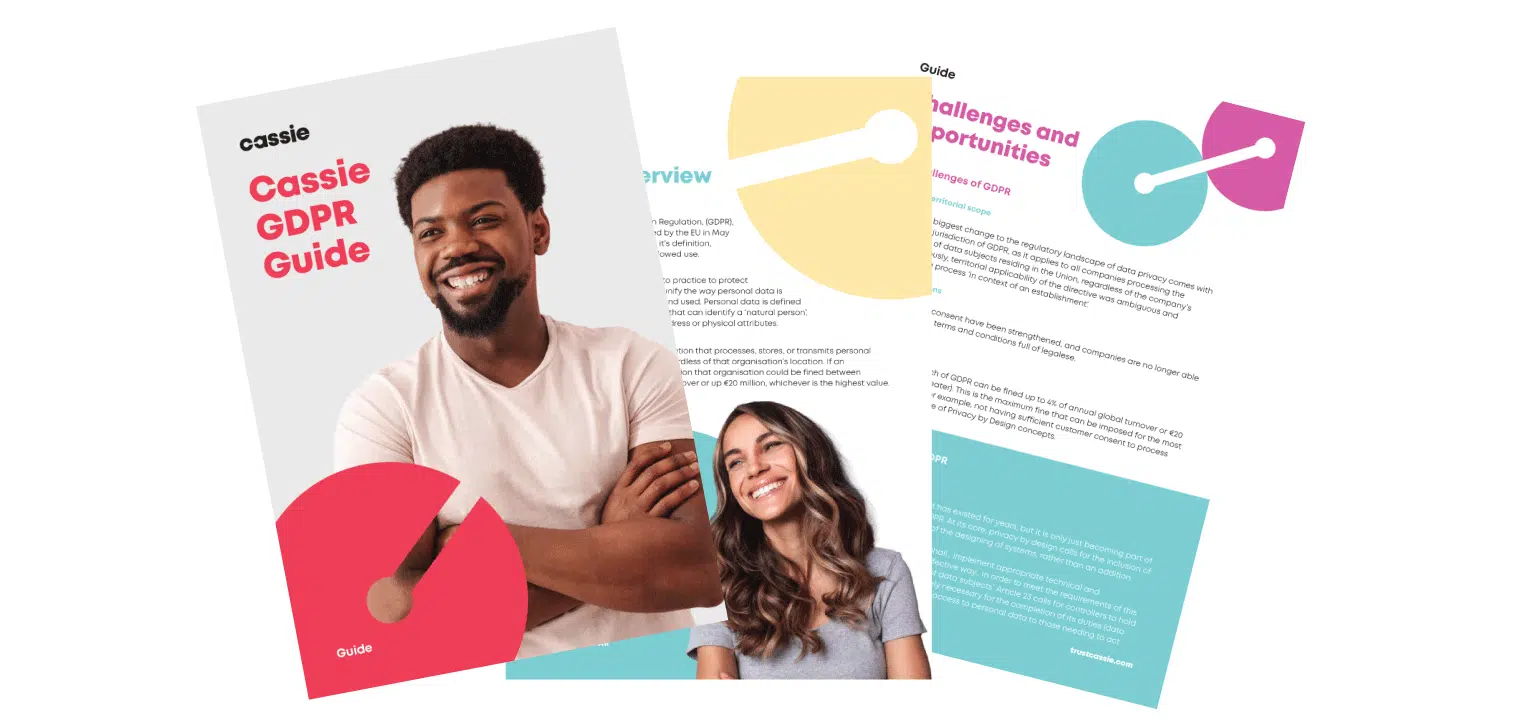Navigating Purpose Limitation in GDPR
Posted: October 9, 2022
For any organization operating online, the term GDPR is likely well-known, particularly among data protection and privacy professionals. But are organizations aware of what the rule consists of, and how they can ensure compliance?
The General Data Protection Regulation (GDPR), enacted in 2018, is comprised of seven key data protection principles that govern how businesses and organizations should handle personal data. These include:
- Lawfulness, fairness, and transparency
- Purpose limitation
- Data minimisation
- Accuracy
- Storage limitation
- Integrity and confidentiality (security)
- Accountability
In order for businesses to remain compliant in their data privacy practices, they should abide by the terms set out in this regulation. In not doing so, organizations can be reprimanded in a number of ways; including being hit with fines and legal warnings, and even facing damages to brand reputation.
In this blog, we focus on how organizations can navigate Purpose Limitation in GDPR, and the benefits of doing so.
What is the purpose limitation principle of GDPR?
The regulation’s second principle, Purpose Limitation, serves to outline the boundaries of how organizations should use the data that they collect from individuals. As stated within the GDPR, organizations should ensure that personal data is “collected for specified, explicit and legitimate purposes” only, with such purposes being clearly established and communicated to individuals.
To ensure full compliance with the principle of purpose limitation, organizations should take the following steps:
- Clearly define the reasons and methods for data collection, establishing specific purposes for which the data will be used.
- Comply with the principle’s documentation obligations by clearly documenting data collection intentions to demonstrate accountability.
- Comply with the principle’s transparency obligations by communicating data collection purposes to individuals, ensuring total transparency.
- Plan for future data collection purposes, as any new purposes will need to be declared according to the above obligations.
By clearly stating the purpose for data collection, organizations can foster trust with consumers by demonstrating fairness and transparency. This therefore encourages individuals to make more informed decisions about consenting to data collection.
What does purpose limitation mean for data?
When declaring the intention behind data collection practices under GDPR’s purpose limitation principle, it’s important to remember that any unfair or unlawful data collection cannot be legitimized or made fair and lawful.
If an organization wants to use the data for a new purpose, it is their responsibility to ensure that the new purpose is either compatible with the original one, or obtain specific consent from their data subjects.
The benefits of GDPR purpose limitation for businesses
- Enhanced trust: By adhering to the purpose limitation principle, businesses can bolster trust with their customers and thus increase brand reputation. In clearly stating the intent behind data collection practices, individuals can feel confident that their data is protected from misuse.
- Legal compliance: The cost of non-compliance for any organization can be staggering. By ensuring adherence to the GDPR’s core principles, organizations can avoid legal troubles, monetary fines, and foster a greater commitment to data protection.
- Data management: Finally, purpose limitation encourages better data management practices. By collecting and categorizing data for specified purposes, organizations can implement the security measures necessary in relation to different types of data, thus mitigating security risks.
The benefits of GDPR purpose limitation for individuals
- Privacy protection: In clearly defining data collection purposes, individuals gain greater control over their personal data. They know exactly why their data is being collected and how it will be used, allowing them to therefore give informed consent.
- Reduced risk of misuse: With clear purposes defined, the risk of data misuse is minimized. This therefore means that individuals can be assured that their data won’t be used for unrelated or harmful activities, encouraging a trusting relationship between brand and consumer.
- Empowerment: The principle empowers individuals by giving them the right to question and challenge the purposes for which their data is being used. This ensures that data subjects have control over their personal information and can hold organizations accountable for any misuse or deviation from the stated purposes.
Why do we need to specify our purposes for GDPR?
Aside from adhering to regulatory standards of data protection, specifying the purpose for collecting user data is critical when it comes to promoting transparency, fairness, and accountability.
Data subjects look for reassurance regarding the protection of their personal information. By fully declaring your purposes, you provide individuals with complete transparency about how their data will be used, granting them total awareness and peace of mind.
Additionally, by integrating effective purpose limitation practices with consent and preference management, individuals can be given complete control over the processing activities they consent to for their data. This approach ensures that data subjects have full autonomy over how their personal information is used, thus promoting trust.
How do we specify our purposes?
Beginning with a clear and comprehensive privacy policy, all data processing purposes should be outlined within documentation to fulfil the obligatory requirements of GDPR. Most importantly, this information should be written up within a clear and accessible privacy notice or privacy policy.
Organizations should be open about how data is being used and provide data subjects with access to this information upon request. A consent and preference management solution can assist organizations in giving individuals the correct control over their data, allowing them to amend or rescind consent at any time. This transparency builds trust and ensures that individuals are aware of and can verify the purposes for which their data is processed.
How can you demonstrate you’ve met this principle?
Ensuring compliance with global regulation, including GDPR, is non-negotiable when it comes to data privacy. Consumers are far more likely to put their trust in a brand that is fully compliant, and so demonstrating a commitment to upholding data protection standards is crucial.
There are several ways that you can demonstrate your compliance with the purpose limitation principle, including:
- Maintaining detailed records of data processing activities, clearly outlining the purposes for which data is collected and processed.
- Performing regular audits to verify that data processing activities are consistent with the specified purposes.
- Promoting transparency with data subjects about the use of their data and providing them access to this information upon request.
What is a ‘compatible’ purpose under GDPR?
Under GDPR, a compatible purpose is one that aligns with the original reason for which the data was collected. To determine if a new purpose is compatible, organizations must consider several factors including context, potential impact on data subjects, and ensuring the appropriate safeguards are in place.
The GDPR declare that any of the following can be considered as compatible purposes:
- Archiving purposes in the public interest
- Scientific or historical research purposes
- Statistical purposes
In a world where personal information is constantly being collected and shared, organizations have an obligation to uphold high standards in their data protection practices. Adherence with purpose limitation, and GDPR as a whole, is essential for navigating the complexities of data privacy.
Purpose Limitation in GDPR FAQs
-
What is the purpose limitation principle of GDPR?
-
The purpose limitation principle under the GDPR ensures that personal data is collected for specified, explicit, and legitimate purposes and not further processed in a manner that is incompatible with those purposes. This means organizations must clearly define the reasons for collecting personal data and cannot use it for any other purpose without further consent or legal basis.
-
-
What are the limitations of the GDPR?
-
The GDPR, while robust, has several limitations:
Complex compliance requirements: Organizations face challenges in understanding and implementing the detailed requirements, which can be resource-intensive without the correct consent solution in place to support. Hefty fines: Non-compliance can result in significant fines, up to 20 million euros or 4% of global annual turnover, which can be particularly burdensome for smaller businesses. Extraterritorial reach: The GDPR applies to organizations outside the EU if they process data of EU residents, complicating compliance for international businesses.
-


